Well what I was trying to do was to model the following using scipy.optimize.minimize.

What I'm trying to optimize is this function with its constraints:

 Here variable V is a list of variables, list's length is equal to the size of Omega.
What I did so far is the following:
Here variable V is a list of variables, list's length is equal to the size of Omega.
What I did so far is the following:
import numpy as np
from scipy.linalg import norm
from scipy.optimize import minimize
# set of concepts
M = ['linear algebra','seq2seq', 'artificial neural network','pointer networks']
#subchapters
S1=['linear algebra', 'differential calculus','backpropagation']
S2=['linear algebra','seq2seq', 'artificial neural network']
S3=['linear algebra','seq2seq', 'artificial neural network','pointer networks']
#vector representation of the subchapter in the concept space
x=[[1,1,0,0],
[1,1,1,0],
[1,1,1,1]]
# set of prerequisite relations among subchapters (entered manually for testing)
Omega = [(1, 2),(2,3),(1,3)]
# number of concepts
m = len(M)
# define of theta and lambda constants (manual)
theta = 2
lamda = 1
# matrix A is a m x m matrix , where m is the number of concepts
# it represents the prerequisite relations among concepts
# A is generated randomly
np.random.seed(43)
#A = np.zeros((m,m), dtype = int)
A = np.random.randint(2, size=(m,m))
# define the slack variable V as an array of size equal to len(Omega)
V = np.empty(len(Omega), dtype=float)
bnds=[]
# bounds -1 and 1 , create the array
# -1 <= a[i][j] <= 1
bnds_a_s_t = [bnds.append((-1, 1)) for _ in range(np.size(A))]
# bounds for the slack variable V, V is positive
bnds_V_i_j = [bnds.append((0,np.inf)) for _ in range(np.size(V))]
#constraints
cons=[]
#equality constraint
#a[s][t] + a[t][s] = 0
def equality_constraint(X):
A_no_flatten=X[:len(X)-len(Omega)]
#reconstruct matrix A
A=np.reshape(A_no_flatten,(m,m))
for s in range(m):
for t in range(m):
r=A[s][t]+A[t][s]
#r=0 constraint
con = {'type': 'eq', 'fun': lambda X: r}
cons.append(con)
# inequality constraint
#x[i].T @ (C[i][j] * A) @ x[j]
def inequality_constraint(X,x):
for couple in Omega:
# get the i and j
i = couple[0]
j = couple[1]
#initialize C to 1s
C = np.full((m,m), 1, dtype = int)
# take all elements from X except last len(Omega) elements
A_no_flatten=X[:len(X)-len(Omega)]
# reconstruct list V
V=X[-len(Omega):]
#index for V
f=0
#reconstruct matrix A
A=np.reshape(A_no_flatten,(m,m))
#construct C[i][j]
for s in range(m):
for t in range(m):
if x[i][t]>0 or x[j][s]>0:
C[s][t]=0
else:
C[s][t]=1
first= x[i].T
second = C*A
third = x[j]
first_sec = first@second
res=first_sec@third
ineq_con = {'type': 'ineq', 'fun': lambda X: res -theta +V[f]}
f+=1
cons.append(ineq_con)
# arguments passed to the function
# here we pass x matrix
# arguments are passed and used in constraints and in the objective function
# the objective function will minimize A and V which are matrix A and slack variable V
arguments=(x,)
# objective function
def objective(X, x):
A_no_flatten=X[:len(X)-len(Omega)]
# reconstruct list V
V=X[-len(Omega):]
#reconstruct matrix A
A=np.reshape(A_no_flatten,(m,m))
# sum of square V
sum_square=0.0
for it in V:
sum_square+=it**2
# sum of square V * lambda
sum_square_lambda=sum_square*lamda
return norm(A, 1) + sum_square_lambda
# list of variables to pass to the objective function
#pass the x0.flatten() which is the A + V combined, and then when in objective function we recreate them
# the first one A is all except the last s items where s is the size of V
# and then V is the rest
B = A.flatten()
p0 = np.append(B,V)
# scipy minimize
sol = minimize(objective, x0 = p0, args=arguments, bounds=bnds, constraints=cons)
print(sol.x)
What I get is the following:
[-7.73458566e-010 0.00000000e+000 4.99999997e-001 1.00000000e+000
1.00000000e+000 0.00000000e+000 -5.00000003e-001 1.00000000e+000
1.00000000e+000 1.00000000e+000 4.99999997e-001 -7.73458566e-010
-7.73458566e-010 0.00000000e+000 4.99999997e-001 -7.73458566e-010
6.01347002e-154 1.07176259e-311 0.00000000e+000]
Which doesn't respect the constraints and is not what I expected
What I don't know is that is it correct to add constraints like that, because I don't seem to call the constraints function, and I need to add them in a loop, and each function depends on X which is the list to minimize.
When I print the cons array it is empty and I know, but I didn't find another way to add the constraint a[s][t]+a[t][s]=0 and the other one, I don't know if my approach is correct, thank you for your help in advance, much appreciated.

